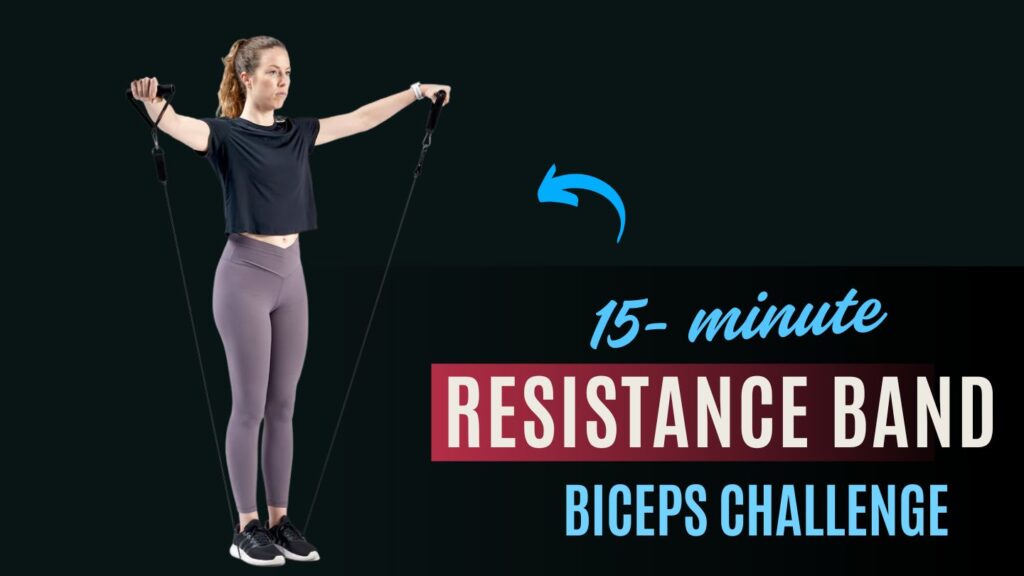Building strong, toned arms isn’t just about aesthetics—it’s about functionality, confidence, and overall strength.
Did you know that your biceps are among the most engaged muscles in daily life? From lifting groceries to carrying your laptop bag, your biceps play a vital role in almost every pulling and lifting motion.
Yet, many people either overtrain them with endless curls or ignore them altogether in favor of larger muscle groups.
Here’s the good news: you don’t need heavy dumbbells or a fancy gym membership to sculpt your arms. A simple resistance band, coupled with the right technique, can help you achieve lean, powerful biceps in just 15 minutes a day.
This resistance band biceps challenge is designed to target your arms with time-efficient, muscle-burning moves that will improve both strength and definition.
Before diving in, let’s bust a common myth:
Myth: You need heavy weights to build strong biceps.
Fact: Research shows that muscles respond to tension and time under load—not just weight. Resistance bands provide constant tension through the movement, which is actually more effective than free weights in some cases.
Now, let’s get started with the exercises.

Table of Contents
What Can Happen After 30 Days of This Challenge
| Positive Changes | Why It Happens |
|---|---|
| Noticeable increase in arm strength | Resistance bands create constant tension, helping muscles adapt and grow stronger over time. |
| Improved muscle tone and definition in the biceps | Consistent resistance training reduces fat in the area and builds lean muscle. |
| Better endurance in daily tasks like lifting, carrying, or pulling | Biceps play a key role in everyday functional movements. |
| Enhanced mind-muscle connection | Regular practice improves your ability to activate and control the biceps effectively. |
| Reduced arm flabbiness and tighter appearance | Repeated training combined with controlled movements burns calories and firms muscles. |
| Increased confidence in upper-body workouts | Building consistency for 30 days makes resistance training feel easier and more natural. |
| Foundation built for progressing into advanced routines | After a month, your arms will be ready for heavier resistance, more sets, or longer workouts. |
Do’s and Don’ts for the 15-Minute Resistance Band Biceps Challenge
| Do’s | Don’ts |
|---|---|
| Warm up your arms and shoulders before starting. | Don’t skip warm-ups—cold muscles are more prone to injury. |
| Maintain slow, controlled movements for maximum tension. | Don’t use momentum or swing the band; it reduces effectiveness. |
| Keep your elbows tucked close to your body during curls. | Don’t let your elbows flare out, as this takes tension off the biceps. |
| Choose the right resistance band for your strength level. | Don’t use bands that are too heavy or too light; both reduce results. |
| Focus on breathing—inhale while lowering, exhale while curling. | Don’t hold your breath; it can cause unnecessary strain. |
| Progress gradually by increasing resistance or sets. | Don’t jump into advanced variations without building a foundation. |
| Stretch your arms after completing the workout. | Don’t neglect cool-downs—they help reduce soreness and stiffness. |
| Stay consistent (3–4 times per week) for lasting results. | Don’t expect overnight transformation; results take time. |
15-Minute Resistance Band Biceps Exercises
1. Resistance Band Bicep Curl
The classic move that directly targets your biceps.
How to:
- Stand with both feet on the resistance band, shoulder-width apart.
- Hold the handles or ends of the band with your palms facing upward.
- Keep your elbows tucked close to your sides.
- Slowly curl the band upward toward your shoulders while squeezing your biceps.
- Lower back down with control.
Pro Tip: Focus on squeezing at the top of the movement and avoid using momentum.
2. Hammer Curl with Resistance Band
This variation hits both the biceps and forearms for a stronger grip.
How to:
- Stand with feet hip-width apart on the band.
- Hold the handles with palms facing each other.
- Curl the band upward in the same motion as a regular curl, but maintain the neutral grip.
- Slowly lower down.
Fun Fact: Hammer curls also activate the brachialis, a muscle that lies underneath the biceps, making your arms look fuller.
3. Concentration Curl with Band
This move isolates the biceps for maximum engagement.
How to:
- Sit on a bench or chair and loop the band under one foot.
- Hold the band with one hand, elbow resting against the inside of your thigh.
- Curl the band upward toward your shoulder slowly.
- Lower back down with control.
Pro Tip: Keep your upper arm still and let the biceps do all the work.
4. Resistance Band Reverse Curl
Great for strengthening both biceps and forearms.
How to:
- Stand with feet on the band, shoulder-width apart.
- Hold the handles with palms facing downward.
- Curl the band up toward your chest, keeping your wrists straight.
- Slowly lower back down.
Did You Know? Reverse curls can help improve wrist stability and reduce the risk of forearm injuries.
5. Resistance Band Zottman Curl
A combination exercise for ultimate arm definition.
How to:
- Start with a normal curl, palms facing upward.
- At the top, rotate your wrists so palms face downward.
- Slowly lower back down in this reverse grip.
- Repeat the sequence.
Pro Tip: This move blends the benefits of both traditional curls and reverse curls.
6. Band Assisted Pull-Apart Curl
Adds shoulder stability while working your biceps.
How to:
- Hold the band with both hands at shoulder height.
- Pull the band apart slightly to create tension.
- Curl your hands toward your shoulders while maintaining outward tension.
- Return to start.
Extra Insight: This engages stabilizing muscles in the shoulders, making it a compound-style biceps move.
7. Single-Arm Resistance Band Curl
Perfect for correcting strength imbalances between arms.
How to:
- Stand with one foot on the band.
- Hold the handle with one hand, palm facing up.
- Curl upward toward your shoulder.
- Lower slowly and repeat before switching sides.
8. Resistance Band Isometric Hold Curl
Builds endurance and muscle stability.
How to:
- Step on the band with both feet.
- Curl the band halfway and hold the position for 20–30 seconds.
- Slowly release back down.
Did You Know? Isometric holds are excellent for building static strength and improving time under tension.
9. Cross-Body Resistance Band Curl
Adds variety and challenges your biceps from a new angle.
How to:
- Stand with both feet on the band.
- Hold the handle with one hand, palm facing inward.
- Curl across your body toward the opposite shoulder.
- Lower back slowly and repeat.
10. Resistance Band Curl to Press
A dynamic move that works both arms and shoulders.
How to:
- Stand on the band with feet hip-width apart.
- Perform a bicep curl.
- Once at the top, press overhead into a shoulder press.
- Lower back down through the same path.
Pro Tip: Keep your core engaged to protect your lower back.
11. Resistance Band 21s
A high-rep finisher for maximum burn.
How to:
- Stand with feet on the band.
- Perform 7 reps from the bottom to halfway up.
- Perform 7 reps from halfway to the top.
- Finish with 7 full-range curls.
Fun Fact: This technique was popularized by bodybuilders to create muscle fatigue and growth.
12. Seated Resistance Band Curl
A great option for beginners or those with lower back issues.
How to:
- Sit on a chair with the band looped under your feet.
- Hold the handles with palms up.
- Curl upward toward your shoulders.
- Lower with control.
13. Resistance Band Drag Curl
Targets the long head of the biceps for peak shape.
How to:
- Stand with feet on the band, holding handles at your sides.
- Instead of curling outward, drag the band upward along your torso.
- Squeeze at the top before lowering.
14. Resistance Band Incline Curl (with chair/bench)
Increases stretch on the biceps for better muscle activation.
How to:
- Sit back on a chair at an incline angle.
- Step on the band with feet to secure it.
- Curl the handles upward with palms up.
- Lower slowly.
15. Resistance Band High Curl
Targets the upper range of motion for biceps.
How to:
- Attach the band to a secure anchor above you.
- Hold handles with palms facing you.
- Curl downward toward your forehead or shoulders.
- Release slowly back up.
The 15-Minute Resistance Band Biceps Challenge
Here’s how you can put it all together into a quick but effective workout routine. Perform each exercise in sequence with minimal rest.
| Exercise | Sets | Reps/Time | Rest |
|---|---|---|---|
| Bicep Curl | 2 | 12–15 reps | 20s |
| Hammer Curl | 2 | 12 reps | 20s |
| Concentration Curl | 2 | 10 reps/arm | 20s |
| Reverse Curl | 2 | 12 reps | 20s |
| Zottman Curl | 2 | 10 reps | 20s |
| Isometric Hold Curl | 1 | 20s hold | 15s |
| Cross-Body Curl | 2 | 10 reps/arm | 20s |
| Curl to Press | 2 | 12 reps | 30s |
| 21s | 1 | 21 reps | 30s |
Total Time: About 15 minutes
Extra Tips for Success
- Control over speed: Focus on slow, controlled movements to maximize muscle tension.
- Adjust resistance: Use thicker bands for more challenge or step wider for increased tension.
- Consistency matters: Doing this challenge 3–4 times per week can help you see visible arm definition within weeks.
- Warm-up and cool-down: Always start with 2–3 minutes of light arm mobility drills and finish with stretching.
Conclusion
Stronger, sculpted arms don’t require hours in the gym or stacks of heavy weights. With just a resistance band and 15 minutes of focused effort, you can build biceps that are not only powerful but also lean and defined. This challenge proves that consistency, proper form, and smart programming matter more than equipment.
Think of this 15-minute resistance band biceps challenge as the starting point. Once you’ve mastered the routine, don’t stop there—keep challenging your muscles to grow. You can progress by:
- Increasing resistance: Switch to a thicker band or double up for more tension.
- Adding sets: Move from 2 sets per exercise to 3 or 4 over time.
- Extending time under tension: Slow down your reps or hold the peak contraction for longer.
- Mixing in variations: Rotate different band exercises each week to avoid plateaus.
For best results, continue this challenge 3–4 times per week for 4–6 weeks. After that, try combining it with triceps or shoulder band workouts to create a complete upper-body resistance band program. By gradually progressing the challenge, you’ll keep your arms growing stronger, leaner, and more resilient.
Remember, the key is not perfection but progression. Stay consistent, listen to your body, and let each session bring you closer to the sculpted arms you’re aiming for.
Frequently Asked Questions (FAQs)
Can resistance bands really build strong biceps like weights?
Yes. Resistance bands provide constant tension throughout the movement, which often engages muscles more effectively than free weights. They are excellent for building strength, endurance, and definition.
How many times a week should I do this 15-minute resistance band challenge?
For best results, aim for 3–4 sessions per week. This allows your muscles time to recover and grow while still keeping the arms consistently challenged.
How long does it take to see results from resistance band biceps workouts?
Most people notice improved strength and a tighter feel in the arms within 3–4 weeks of consistent training. Visible definition may take 6–8 weeks depending on your fitness level, diet, and overall activity.
Are resistance band biceps workouts good for beginners?
Absolutely. Resistance bands are safe, low-impact, and easy to adjust for different fitness levels. Beginners can start with lighter bands and fewer reps before progressing to heavier resistance.
Do I need different resistance bands for this challenge?
Not necessarily. A medium-resistance band works for most people. However, having a set of bands with varying resistance levels (light, medium, heavy) allows you to progress as your strength improves.
Can I combine this with other workouts?
Yes. This 15-minute biceps challenge can easily be added to a full-body workout routine, paired with triceps or shoulder exercises, or even used as a quick arm finisher after cardio or core training.
Will resistance band curls make my arms bulky?
No. Resistance bands primarily help sculpt, tone, and strengthen the arms. Building bulky muscles requires a very high level of resistance combined with specific nutrition strategies. Most people will achieve leaner, more defined arms with this routine.
Is 15 minutes really enough for biceps training?
Yes. If performed correctly with good intensity and minimal rest, 15 minutes is sufficient to fully fatigue and stimulate the biceps for growth and definition.
Can this workout replace my gym arm day?
It can. For people who don’t have access to dumbbells or machines, this resistance band workout provides an effective alternative that targets the same muscles.
What should I do after completing this 15-minute challenge for several weeks?
Once you adapt, you can increase resistance, add extra sets, slow down your reps, or expand the workout into a full 30-minute upper-body challenge by including triceps, shoulders, and back exercises with bands.










